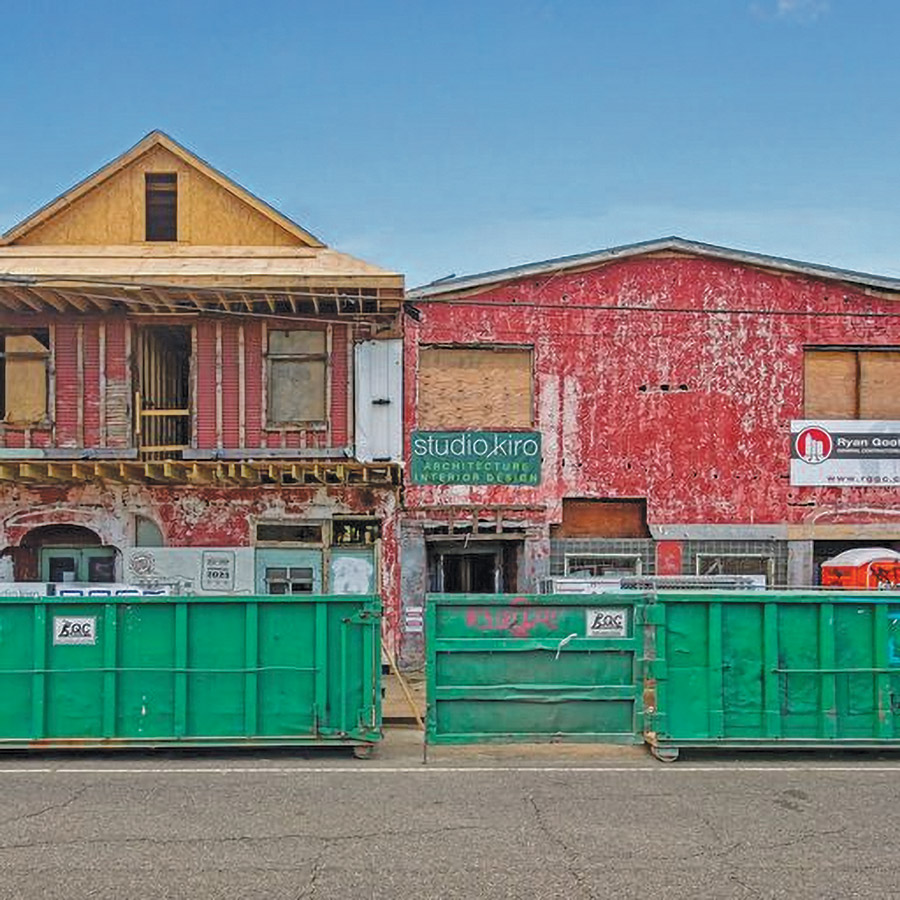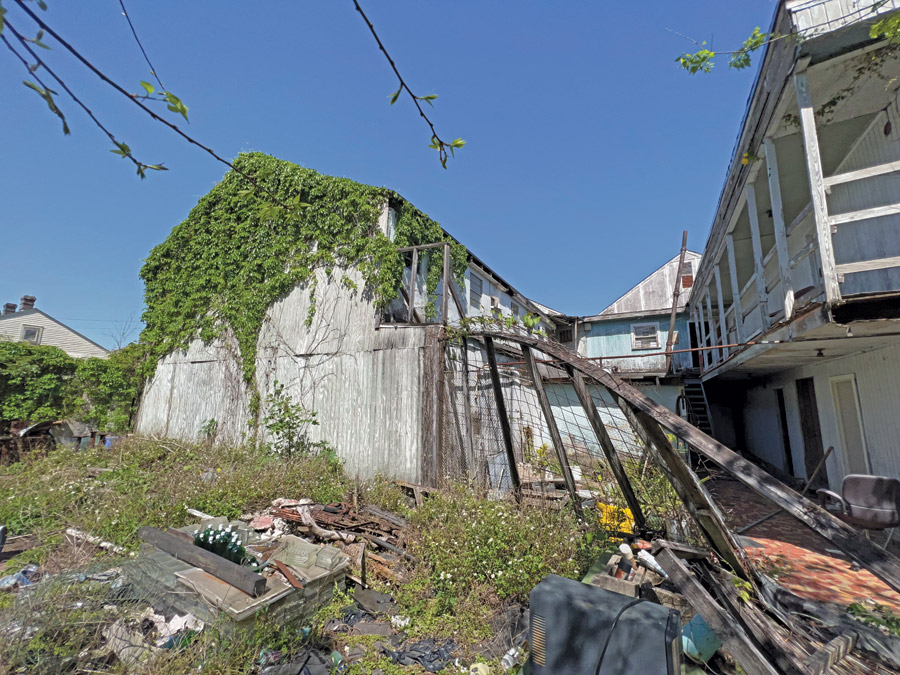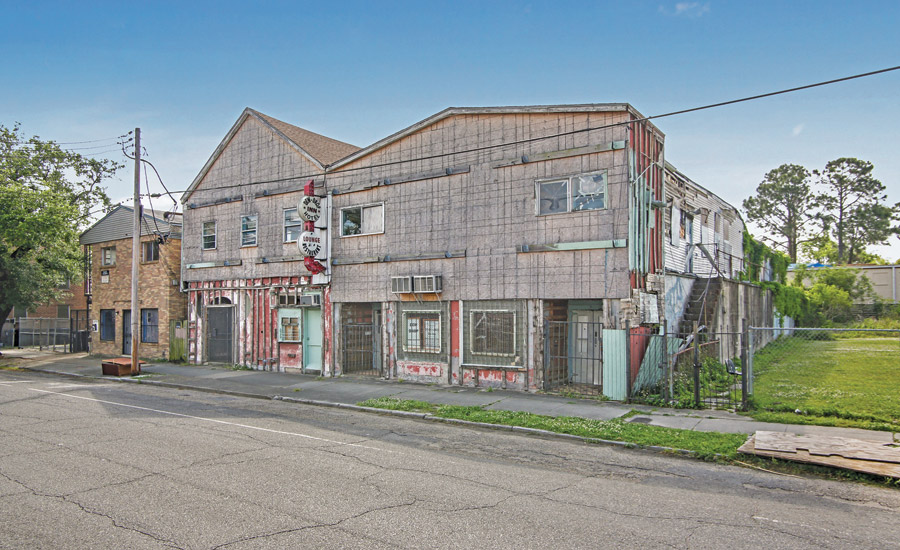After suffering from years of lack of maintenance and water intrusion from Hurricane Katrina, the Dew Drop Inn, the legendary New Orleans hotel and nightclub, which once boasted greats like Ray Charles and Little Richard, is finding new life as contractors near completion of a historic renovation before the landmark’s planned opening this fall.
“Historic preservation projects of this magnitude require much planning, time and attention to detail,” says Pat Thomas, project executive at Ryan Gootee General Contractors. “With a deteriorated structure such as this, there was a ton of coordination with the civil and structural engineers and architectural team to make sure that we were rehabilitating the structure properly in conjunction with the historical preservation requirements.”
The passage of time, exposure to the elements and abandonment had contributed to the LeSalle Street structure’s dilapidated state. Surprisingly, says Thomas, the “majority” of the original materials were salvageable, though some doors, windows and structural members in the corridors were beyond rehabbing. The texture on all of the nightclub’s ceilings and walls contained hazardous materials.
The rehabilitation team worked closely together. A historic consultant worked with a local woman- and minority-owned architecture firm, Studio Kiro, to meet the scope of work for the program requirement to preserve the space as it originally was, while still allowing for modern use.

Once famed for its musical guests, the building sat abandoned for years.
Photo courtesy of Studio Kiro
Studio Kiro principal Miwako Hattori says the Dew Drop renovation was “extremely complex,” partially because the structure was originally two separate buildings. “We reconstructed the hotel corridors as close as possible to the original style. When they renovated the buildings [into one structure,] they retained the original exterior walls. We removed the ceiling and exposed the exterior walls so you can view the interior of the music venue,” she says.
Preserving the original architectural styles was crucial. “The hotel side of the building retains its Craftsman details, and the music venue side has Art Deco characteristics,” Hattori says.
The team also reconstructed the original street-facing balconies, a signature of New Orleans. “This will allow New Orleans traditional interface between the hotel and street life below. We created the second-floor suites, which overlook the stage, to further the legacy of [a second, ground-level venue,] the Groove Room, which was demolished in the late 1990s,” the architect says.
“This building plays an important role in the musical history of New Orleans and is a cultural landmark for this community in particular.”
—Patrick Thomas, Project Executive, Ryan Gootee General Contractors
The project’s builders say the entire structure was “extraordinarily deteriorated.” Additionally, the hazardous materials on all of the nightclub’s ceilings had to be removed.
“We had to abate the entire building in sections and receive air clearances before we could commence with the selective demolition,” says Thomas. “From there, we spent several months installing new spread footings, grade beams, columns, beams and fortifying the existing studs, joists and rafters.”
However, the team took pains in keeping as much original materials as possible, making it a true “historical preservation project.”
“What we pulled away, we put back,” says Thomas, of keeping the rehab job of the nearly 13,000-sq-ft building as close to the original as possible. If a window was not salvageable, they replaced it with a refurbished window from the era. All replaced items had to be approved by Louisiana’s State Historic Preservation Office, or SHPO.
In early May, builders were nearing completion of the mechanical and electrical rough-in stage, with drywall installation and finishes to follow as well as placement of concrete for the swimming pool shell. When the revitalized Dew Drop Inn opens, it will include a music hotspot, nightclub and a 17-room boutique hotel. Each hotel room will be programmed as a unique exhibit that honors the musicians and civil rights activists who contributed to the Dew Drop’s legacy. Civic Studio, a diverse collaborative of creatives in the neighborhood, will be spearheading the programming.

Unlike the original structure, the renovated building will include a swimming pool.
Rendering courtesy of Studio Kiro
“This building plays an important role in the musical history of New Orleans and is a cultural landmark for this community in particular,” says Thomas. “We believe that restoring it to its former glory will add vibrancy and entertainment to this neighborhood, and we hope will encourage further commercial development in the area.”
The building’s historic status came with a few economic benefits. In 2022, The Dew Drop Inn was placed on the National Register, allowing a 20% historic rehabilitation tax credit on qualified project costs from the federal government. The project also qualified for a 20% historic rehabilitation tax credit from the state of Louisiana.
Real estate developer and New Orleans native Curtis Doucette, who purchased the venue in January 2021, says his main objective is to give the venue its “proper reverence.”
During an era of legal segregation, the Dew Drop Inn was a must on the famed Chitlin’ Circuit, nightclubs where eminent Black musicians played. Greats such as Ray Charles, Little Richard, Marvin Gaye, Etta James, Sam Cooke, Aretha Franklin, Allen Toussaint and Irma Thomas all played at the storied venue.
“I’m working with a host of independent Black contractors to handle the various marketing activities that the project requires. You’ll see the same commitment to equity as I assemble the operations team.”
—Curtis Doucette, Developer
“The Dew Drop Inn provided that safe space,” says Doucette. “Out of necessity, all of the greats came together in this space to create magic.
“This place holds a special place in history, even beyond the musical contributions,” he says. “There is significant civil rights history here. It also serves as an example of Black economic resilience and joy during a very trying time.”
In April 2021, New Orleans’ city council unanimously approved plans to revive the venue, which rests in the Central City neighborhood, a historically working-class area that developed in the mid-nineteenth century.
Integral to Doucette’s real estate and passion projects is to use development to promote equity. “When you have equity and ownership, you’re in a better position to promote equity and diversity,” he says.
“I always say that as a real estate developer, I may or may not make a lot of money, but one thing that you can’t deny is that I spend a lot of money,” Doucette says. “With that, I have the power to create opportunities for others. I’m committed to that during development and beyond as we operate. We don’t have to ask for permission to actualize our values.”
The majority of the Dew Drop’s investors are Black, which Doucette says is important. He is also taking care to hire local minority-owned businesses and is working with Ryan Gootee General Contractors, to find ways to hire subcontractors certified as disadvantaged business enterprises.
“Additionally, I’m working with a host of independent Black contractors to handle the various marketing activities that the project requires. You’ll see the same commitment to equity as I assemble the operations team,” Doucette says.

Abandoned after Hurricane Katrina devastated parts of New Orleans, the celebrated Dew Drop Inn will return as a music attraction.
Photo courtesy Studio Kiro
In the project’s nascent stages, the developer hired a historic consultant to help apply the inn for listing on the National Register of Historic Places. While the venue deserved to be on the list, it didn’t necessarily look like it at the time of Doucette’s purchase, Gabrielle Begue, the Historic Consultant at Ryan LLC, recalls. “It wasn’t recognizable as the Dew Drop anymore,”
After the club’s heyday, owner Frank Painia installed a modern facade in 1969 and 1970. Doucette’s team needed to uncover if the historic facade was still intact underneath.
“That was a really exciting day,” Begue says. “It wasn’t in the greatest shape; it had been shaved off and the balcony had been cut off. The curved stucco parapet on the venue side and the storefront hand-painted signage were there. There were lots of really cool features that had been hidden for 50 years.”

